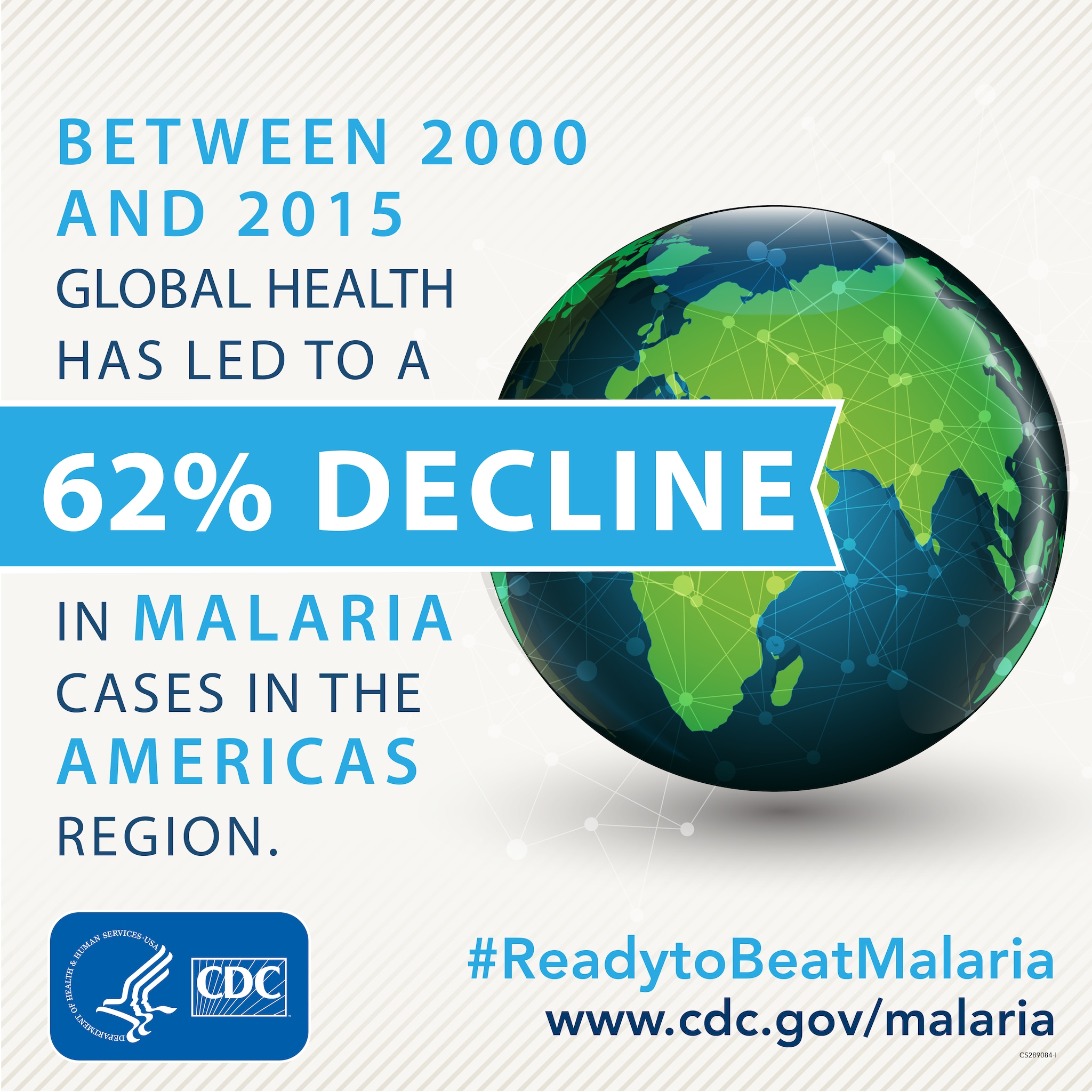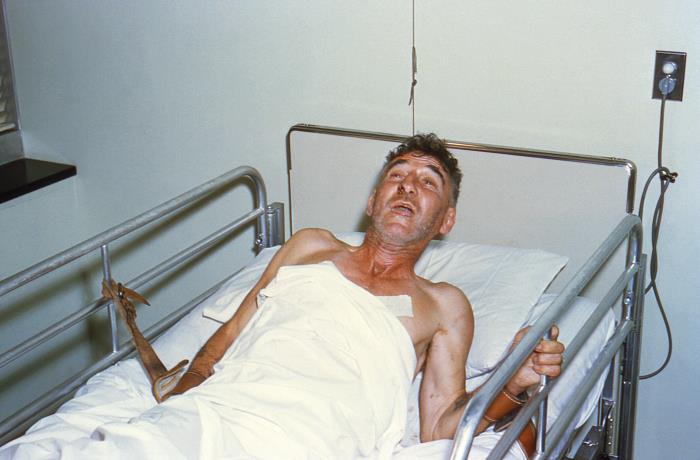As temperatures frequently rose above 90 degrees, the lack of power in nursing homes, private houses and hospitals hit the elderly particularly hard. Soaring temperatures accelerated the deaths of people who were already seriously ill. Ambulances could not arrive, medicines ran out and oxygen tanks that ran on electricity were useless, several funeral directors said….”
Archive for November, 2017
Smoke mixed with fog, dust, and industrial pollution form a particularly thick haze in northern India.
Saturday, November 11th, 2017
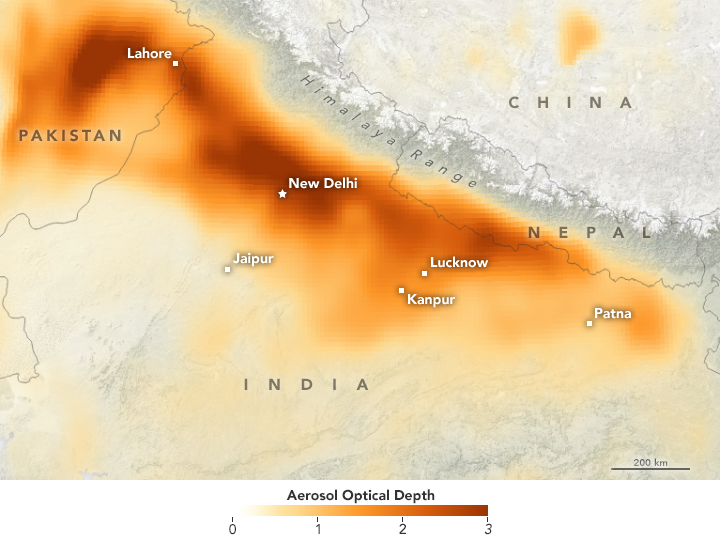
Since mid-October 2017, smoke from crop fires in Punjab and Haryana has blown across northern India and Pakistan. With the arrival of cooler weather in November, the smoke mixed with fog, dust, and industrial pollution to form a particularly thick haze. A lack of wind, which usually helps disperse air pollution, worsened the problem for several days in November.
On November 7, 2017, the Moderate Resolution Imaging Spectroradiometer (MODIS) on NASA’s Aqua satellite captured this natural-color image of haze and fog blanketing the region. The second image, a data map based on observations from the same sensor, depicts aerosol optical depth, a measure of how airborne particles affect the reflection and absorption of light by the atmosphere. Red-brown colors indicate skies thick with aerosol pollution. Several major cities—including Lahore, New Delhi, Lucknow, and Kanpur—faced elevated levels of pollution. As seen in the third image, which was captured by Terra, thick haze continued to linger over the region on November 8, 2017.
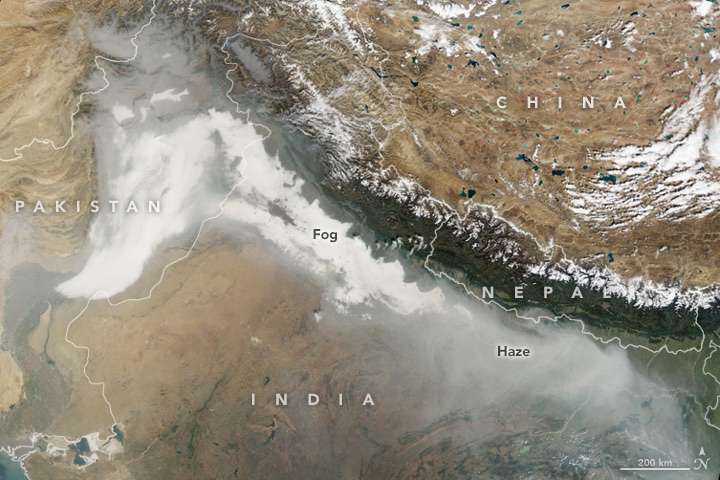
In New Delhi, particulate pollution rose several times above the limit considered safe. On November 8, 2017, an air quality sensor at the U.S. embassy recorded a peak air quality index of 1,010—an extremely hazardous level. Values of 0 to 100 are considered acceptable.
In response, authorities in Delhi have closed schools, banned trucks from entering the city, halted construction projects, and increased parking fees to discourage driving. With hospitals recording a surge of people complaining of respiratory problems, the Indian Medical Association has declared the situation a public health emergency.
-
References
- Aljazeera (2017, November 8) What’s PM 2.5 and why is New Delhi, Lahore smog so bad? Accessed November 8, 2017.
- Hindustan Times (2017, November 8) Delhi air pollution prompts officials to close schools, halt construction, entry of trucks. Accessed November 8, 2017.
- The Guardian (2017, November 7) Delhi doctors declare pollution emergency as smog chokes city. Accessed November 8, 2017.
- The Tribune (2017, November 7) Stubble burning reaches new high. Accessed November 8, 2017.
- U.S. Department of State New Delhi — PM2.5. Accessed November 8, 2017.
A cloud of mysterious radioactive material appeared over Europe last month.
Saturday, November 11th, 2017“…..Monitors in Italy were among first to detect the radioactive isotope ruthenium-106 on Oct. 3, according to a fresh report by France’s Radioprotection and Nuclear Safety Institute, known as IRSN. In total, 28 European countries saw the radioactive cloud, the report says.
The multinational Comprehensive Nuclear-Test-Ban Treaty Organisation, which runs a network designed to monitor for nuclear weapons tests, also confirmed to NPR that it had detected the cloud…..Based on the detection from monitoring stations and meteorological data, the mysterious cloud — which has since dissipated — has been traced to somewhere along the Russia-Kazakhstan border…….”
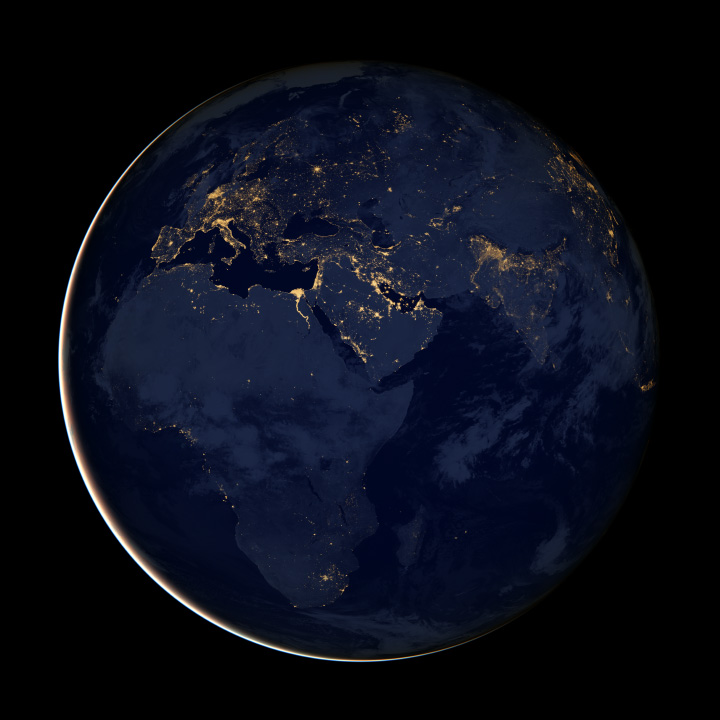
09/11/2017
Detection of Ruthenium 106 in France and in Europe: Results of IRSN’s investigation
“Ruthenium 106 has been detected in late September by several European networks involved in the monitoring of atmospheric radioactive contamination, at levels of a few milliBecquerels per cubic meter of air. IRSN’s investigations make it possible to provide information on the possible location of the source of the release as well as the order of magnitude of the quantities released.
As soon as it became aware of the first detections of Ruthenium 106 in the atmosphere in Europe, IRSN mobilized all its means of radiological monitoring of the atmosphere and conducted regular analysis of the filters from its monitoring stations. For the period from September 27 to October 13, 2017, only the stations of Seyne-sur-Mer, Nice and Ajaccio revealed the presence of Ruthenium 106 in trace amounts. Since October 13, 2017, Ruthenium 106 is no longer detected in France.
Measurement results from European stations communicated to the Institute since October 3, 2017, have confirmed the presence of Ruthenium 106 in the atmosphere of the majority of European countries. The results obtained for sampling periods later than October 6, 2017, showed a steady decrease in Ruthenium 106 levels, which is currently no longer detected in Europe.
The concentration levels of Ruthenium 106 in the air that have been recorded in Europe and especially in France are of no consequence for human health and for the environment.
Based on the meteorological conditions provided by Météo France and the measurement results available in European countries, IRSN carried out simulations to locate the release zone, to assess the quantity of ruthenium released, as well as the period and the duration of the release.
The map below summarizes the results obtained and confirms that the most plausible zone of release lies between the Volga and the Urals without it being possible, with the available data, to specify the exact location of the point of release. Indeed, it is in this geographical area that the simulation of a ruthenium release makes it possible to better reproduce the measurements obtained in Europe….”
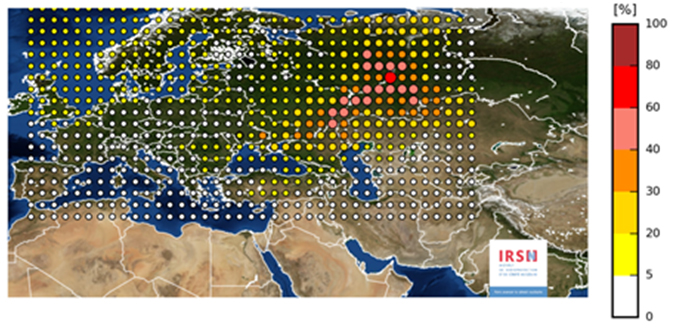
“…..Because of the quantities released, the consequences of an accident of this magnitude in France would have required to implement locally measures of protection of the populations on a radius of the order of a few kilometres around the location of the release.
For foodstuffs, the exceeding of maximum permitted levels (1250 Bq/kg for Ruthenium 106 for non-milk products) would be observed over distances of the order of a few tens of kilometres around the location of the release.
The possibility of exceeding maximum permitted levels near the accident site led IRSN to study the scenario of importing foodstuffs from this area. From this analysis, IRSN considers, on the one hand, that the probability of a scenario that would see the importation into France of foodstuffs (especially mushrooms) contaminated by Ruthenium 106 near the source of the release is extremely low and, on the other hand, the potential health risk associated with this scenario is also very low. It does not therefore appear necessary to introduce systematic controls on the contamination of imported foods……”
NC air traffic controller was charged with three counts of manufacturing a weapon of mass destruction and one count of possession of a weapon of mass destruction
Saturday, November 11th, 2017“…..Police did not say what Dandan’s intentions were or whether he took the bomb to the airport…..”
FEMA: 3,000 residents of Puerto Rico still living in shelters to be sheltered in New York and Florida
Friday, November 10th, 2017“…..The Federal Emergency Management Agency said that it was finalizing extraordinary plans to fly about 3,000 residents of Puerto Rico still living in shelters to New York and Florida.
“Transportation assistance is something that I don’t think we have done previously,” Will Booher, a FEMA spokesman, said. “But this is unique to what’s going on in Puerto Rico.” The agency said the relief effort was being undertaken at the request of Gov. Ricardo Rosselló.
FEMA regularly finds housing for hurricane victims, often at hotels or motels nearby. But because there is so little available lodging on the island, and no easy way to get people from shelters to safe housing, the agency is arranging charter flights for residents, beginning with those still in shelters…..”
Puerto Rico: 472 more people died this September compared with the same month last year.
Friday, November 10th, 2017“…..On Wednesday, Puerto Rico officials, facing increasing questions about the accuracy of the official death toll from the storm, acknowledged for the first time that 472 more people died this September compared with the same month last year. The storm made landfall on Sept. 20. The government’s official death toll is 55.
The numbers confirmed what had been speculated for weeks: After the waters receded and the roads were cleared, people here continued to die at rates far beyond normal.
Nov. 9, 1965: The great Northeast blackout occurred as several states and parts of Canada were hit by a series of power failures lasting up to 13 1/2 hours.
Thursday, November 9th, 2017EPA Registers the Wolbachia ZAP Strain in Live Male Asian Tiger Mosquitoes in order to reduce their population thereby reducing the spread numerous diseases of significant human health concern
Thursday, November 9th, 2017
For Release: November 7, 2017
On November 3, 2017, EPA registered a new mosquito biopesticide – ZAP Males® – that can reduce local populations of the type of mosquito (Aedes albopictus, or Asian Tiger Mosquitoes) that can spread numerous diseases of significant human health concern, including the Zika virus.
ZAP Males® are live male mosquitoes that are infected with the ZAP strain, a particular strain of the Wolbachia bacterium. Infected males mate with females, which then produce offspring that do not survive. (Male mosquitoes do not bite people.) With continued releases of the ZAP Males®, local Aedes albopictus populations decrease. Wolbachia are naturally occurring bacteria commonly found in most insect species.
This time-limited registration allows MosquitoMate, Inc. to sell the Wolbachia-infected male mosquitoes for five years in the District of Columbia and the following states: California, Connecticut, Delaware, Illinois, Indiana, Kentucky, Massachusetts, Maine, Maryland, Missouri, New Hampshire, New Jersey, Nevada, New York, Ohio, Pennsylvania, Rhode Island, Tennessee, Vermont, and West Virginia. Before the ZAP Males® can be used in each of those jurisdictions, it must be registered in the state or district.
When the five-year time limit ends, the registration will expire unless the registrant requests further action from EPA.
EPA’s risk assessments, along with the pesticide labeling, EPA’s response to public comments on the Notice of Receipt, and the proposed registration decision, can be found on www.regulations.gov under docket number EPA-HQ-OPP-2016-0205.
Latest research: Rabies in bats and carnivores, and implications for spillover to humans
Thursday, November 9th, 2017Comparative pathogenesis of rabies in bats and carnivores, and implications for spillover to humans
Published online: October 31, 2017
Lineke Begeman, Corine GeurtsvanKessel, Stefan Finke, Conrad M Freuling, Marion Koopmans, Thomas Müller, Tom J H Ruigrok, Thijs Kuiken
The Lancet Infectious Diseases
http://www.thelancet.com/journals/laninf/article/PIIS1473-3099(17)30574-1/fulltext
Madagascar: UN officials now put the ever changing case tally in the epidemic that began on August 1 at 1,947 confirmed, probable and suspected cases of plague through Nov. 3.
Wednesday, November 8th, 2017- 1,437 (74%) were clinically classified as pulmonary plague
- 295 (15%) were bubonic plague
- one was septicemic
- 211 were not yet classified (further classification of cases is in process).
- The death count has risen to 143.
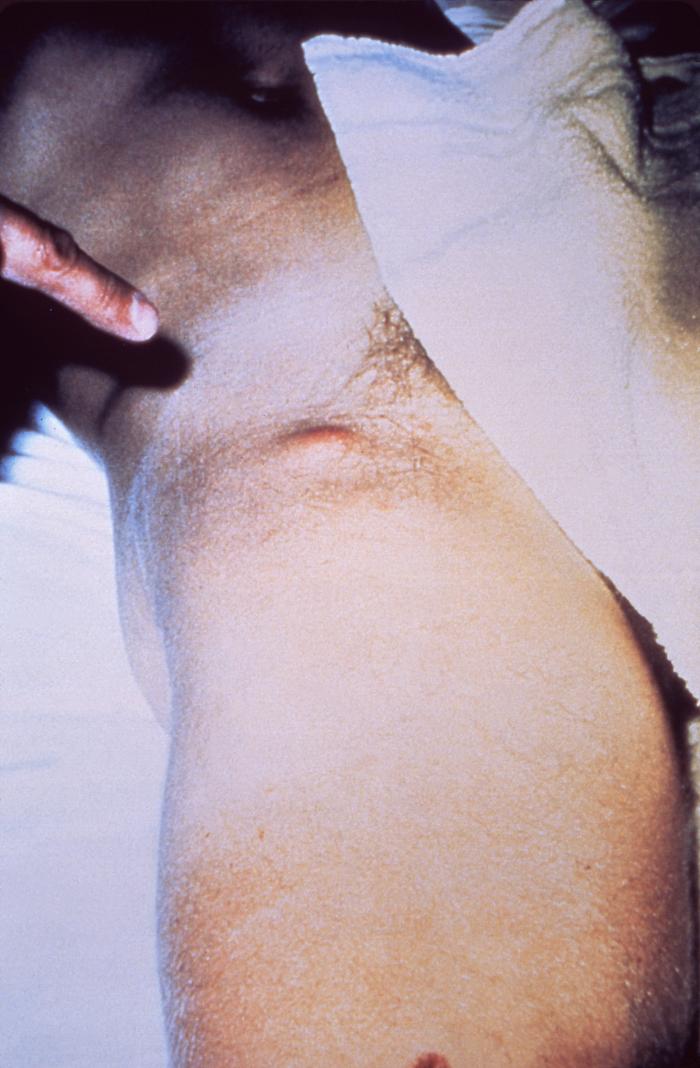
CDC-PHIL


